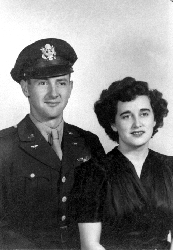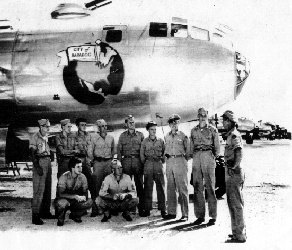The following are some excerpts from the story of U.S. bomber pilot Garvin Kowalke's chapter in The Hero Next DoorTM
Garvin R. Kowalke had flown through many harrowing flights from April through July, 1945 including an ocean crash and rescue, his heroics during which earned him the Distinguished Flying Cross. But none proved as important as two non-bombing, support flights he piloted in August.
On Aug. 4, 1945, Kowalke piloted a B-29 he had named The City of Barabooso named after his hometownon a secret weather reconnaissance flight. His assignment? To determine if conditions were right, and to obtain wind direction and velocity and temperature, for an Aug. 6 atomic bombing of Hiroshima.
On Aug. 9, The City of Baraboo flew a secret mission again, this time to conduct radiation level tests over Hiroshima.
Two days before the Enola Gay dropped its single bomb on Hiroshima, The City of Baraboo was equipped with special equipment for determining weather information and a meteorologist was also assigned to collect the weather data.
The history changing flight took just under 20 hours as Kowalke guided The City of Baraboo through a rather uneventful run from the jungle air strip in Guam, across regions of China and Manchuria, over Iwo Jima and to Hiroshima and back.
Though Kowalke knew somewhat about why they were testing weather conditions that day, he believes his crew was sure it was just another weather reconnaissance mission. "We did do weather reconnaissance flights before the one for Hiroshima. We crossed Japan up to Manchuria to check wind direction, temperature and speed so the bombardiers would have that information on the bombing runs."
This time such weather informationespecially wind speed and directionwould be critical to getting the atomic bomb on target. And, to getting it dropped before the fast approaching Pacific monsoon season hit. "Our mission came just in time, it turns out, as the weather deteriorated quickly in August and we remained grounded for several days in September."
The real reason for The City of Baraboo's radiation testing mission Aug. 9 proved more difficult to disguise for the crew not privy to the top secret information.
"As aircraft commander, I was the only one aware of what we were doing, but the whole crew was like 'what's going on?' because our plane had all this different equipment besides the regular weather stuff on it. We looked like a flying porcupine."
Different indeed, as the porcupine-like equipment was necessary to measure the radiation levels in the city, assess the damage and determine how safe it was for American troops to enter. A special technician was also assigned to take readings and Kowalke was instructed to fly over Japan at various altitudes to determine safe radiation levels for planning future missions.
How safe the radiation was for The City of Baraboo crew flying in to test it was of seemingly little concern. The crew wore no protective clothing to guard them from possible radiation exposure.
"On that mission, if the level of radio-activity reached a certain point, we were to climb. If it reached yet another point, we were to immediately turn around and go back. The aircraft was completely equipped with radiation instruments and we had all these extra professionals aboard to read it and give me the go ahead to get out of there fast if it was too high. But according to them we were never in danger."
The readings indicated all was safe enough to stay in the area and Kowalke got a bird's eye view of the destruction. "We flew across at 25,000 to 35,000 feet and I saw it out my right wing first. It wasn't much different than a massive fire bomb raid. The city was blackened and looked like it was hit by a massive fire bombing run, but it was gone, completely gone."
From his altitude Kowalke and crew saw "thankfully saw little true detail" of atomic destruction, although they saw enough to know that this one bomb would end the war, he says.
As he looked at the destruction, Kowalke says he was hit with a sobering thought: "What was impressive was that when you'd look at the devastation you knew it would have taken 300 fire bombers one night to do that kind of damage. We thought if they can do all that with one aircraft, one mission, one bomb. That's the best cottin' pickin' mission they could run. This war is over. The thing was the radiation and what it did to the people and that's hard.
"When that atomic bomb hit, and the one hit Nagasaki later, that gave the Japanese Emperor a way to end the war and save face. That saved thousands of our lives, probably my life."
And, it meant that the one-time farmer could soon return home to his wife of five years Roberta, and the hometown he loved. "I often get asked 'why did I name my plane The City of Baraboo?' Well, I wanted to name my plane and I couldn't very well name her 'Butch.' And, I'm a homebody and that was my home city and I'm proud of it. I wanted everyone to know about my hometown. That's just how I always felt. And I'm as proud of that plane as I am of the hometown I named her after. She was one great bird!"
CONTINUED SERVICE
With the war over, Kowalke could return home to the town he loved. But, he didn't stay long. Kowalke's military service, however.
Kowalke stayed in Amy Air Corps, and later the Air Force, for 28 distinguished years, flying through three wars and earning the Distinguished Flying Cross, four Air Medals and the Purple Heart. He was also awarded the General Foulois Award for flight safety and Air Force Commendation Medal in addition to his many theater ribbons and other honors.
After W.W. II he went into the reserves but couldn't stay out of the cockpit and so re-applied for active duty in time to serve in the Korean War as a B-29 and B-57 pilot and instructor, stationed on Johnson Air Force Base, Japan. He moved his family back to Wisconsin in 1968 and remained in the service through the first years of Viet Nam, where he flew 12 missions with the Snoopy Squadron in DaNang, as a flight examiner for the forward air control squadron. Kowalke was promoted to lieutenant colonel and assigned to Air Force Intelligence until his retirement in 1970.
After retirement, Kowalke, his wife and two children returned to Baraboo where Kowalke served his hometown as the Sauk County Director for the Wisconsin Emergency Management Agency. He held the post until 1985 when Roberta's health necessitated a move to San Antonio, Texas, for special medical treatment. They returned to Baraboo in 1987 when those treatments failed; Roberta died in 1989.
For all his war flying heroics and community service accolades, the adoptions of his childrena son and daughterremain the greatest moments of his life, Kowalke beams. Kowalke's strongest sense of duty was then, and remains, to his family and country. He wittingly sacrificed much for botha hometown boy fighting for a love to come home to.
Read more about Garvin Kowalke including about his ocean rescue and many of his subsequent 15 combat missions as pilot of The City of Barabooin his chapter in The Hero Next DoorTM. Click on the Shop link above to order.



